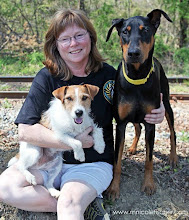I heard an interesting interview on NPR the other day with a man called Salman Kahn. He's an educator who uses You Tube to tutor students in subjects as diverse as arithmetic and the French Revolution. In explaining why he started this service, he mentioned that since everyone learns at his or her own rate, in a typical classroom setting that could mean that one person misses out on learning, say, 5% of the material and another may miss out on 20% because he or she doesn't learn at the same rate as the rest of the class. So, as those people start their next class they already have a 5% or 20% gap in learning which means they'll probably increase that learning gap as they go along and most likely drop out of class. He called that "an accumulation of failure" and thought it happened in almost every classroom.
This made me wonder about agility group classes and how they're taught. As instructors, are we losing people from the sport because they don't learn at the same rate as the majority of students? I would hate to think that anyone in my classes is dropping out because I can't accommodate their style of learning and yet I know how common it is to have a group class where every team has a different foundation and a different level of experience in dog training. It can be extremely challenging to design a class that will meet everyone's needs.
I also think that it's up to the student to make sure the instructor knows that they feel they're being left behind in some way. Sometimes I'm so focused on getting my point across that I may miss the non-verbal signals the student is sending and I hope all of my students know that my primary interest is in helping them learn the most they can in my classes. And even though I'd want to know if they were having any kind of trouble with my presentation of the material, I also know how hard it is to feel like you're the only one in class somehow "not getting it".
I used to feel that way quite a lot in my college organic chemistry class and when I approached the professor to tell him I was feeling lost, he told me that if I felt that way I probably shouldn't be in the class. At the time I was a returning university student so I was older than most of my classmates and I already felt at a disadvantage due to the lapse of time between my high school chemistry classes and the one I was currently taking. I also knew, because I had had quite a few years in the work force by then, that what he was saying was almost certainly a bunch of bullsh*t :-) I had already learned by that point in my life that if there's something you want to learn, you can learn it given the right teacher.
My next step was to attend the common tutorial sessions offered free of charge by the university. They were some help but there were many students and only one teaching assistant. It really wasn't much help. So I scraped together enough money to hire a tutor and she really tried her best to help me but I still just wasn't getting it so she referred me to another tutor and I will always be grateful she did.
The new tutor was so good at explaining things to me that I actually started to enjoy the class and looked forward to the homework. After several sessions with this tutor I had my second exam of the semester and got a B rather than the D I'd gotten on the first exam. With continued tutoring by this young woman, I was able to start solving problems on my own and I think ended up with an overall B in the class. Of course, what I really got was much more than that. What I really got was the belief that I could learn anything if it was explained in the right way.
That self-confidence has been very useful over the years and I attribute my eventual career in clinical laboratory science to learning that it's all about finding the right teacher. Sometimes you might have to go through several teachers to find the one who can break things down into understandable bits for you and not everyone has the option of choosing between instructors but I'm convinced that the right one is out there if you can just find her.
Subscribe to:
Post Comments (Atom)

I found this to be very true. That lead me to teach 90% in privates.
ReplyDeleteI should also add that I think agility is a bit different from organic. In a team, I think you have to address the handler, the dog, the fundamentals skills each possess and their weaknesses. In organic, mechanics of the student are less important. So I personally do not believe it is possible to work in a group and get the maximum information and help that the team needs. You get what most teams need. And then you pay someone for private lessons to get the things that were glossed over or missing.
ReplyDeleteGreat post! The right teacher is so important. Students appreciate someone who is patient and creative, and this type of teacher can be successful in group or private settings.
ReplyDelete